Content Modeling with Structured Content Explained
Content modeling is the practice of defining structured content for your websites, apps, or any digital platform.

Instead of dumping content into giant blobs of text, you break it down into well-defined types (like articles, products, authors) and fields (title, body, price, etc.), along with the relationships between them. This upfront planning might sound technical (and it is), but it dramatically improves how you manage, reuse, and deliver content across channels.
In short, a content model gives clear structure and organization to your content, serving as a blueprint that guides content creators, designers, and developers.
With a good content model in place, you can manage content more efficiently, ensure consistency, enable omnichannel presence and publishing, and even boost SEO by providing content in a format that’s easier for search engines (and LLMs) to understand.
Whether you’re a developer or a business strategist, content modeling helps align teams, ie, everyone has a clear understanding of what type of content exists and how it’s structured.
With that being the case, let’s explore what content modeling means and why it’s worth your attention.
This article is the first one in the content modeling series here at Crystallize:
Content Modeling Explained > Content Modeling Step-by-Step Guide (with Examples) > Content Modeling Tools and Organization
We urge you to read all three articles. By the end, you’ll understand how content modeling turns content chaos into a well-organized library — saving time, improving quality, and setting the stage for scalable, future-friendly content. 🚀
What Is Content Modeling?
Content modeling is the process of defining the structure of your content in a formal and systematic manner. It involves breaking down content into content types (sometimes referred to as content classes or templates) and fields (the attributes of those types), and specifying how those pieces relate to each other.
Instead of treating a web page or document as one big blob of text, you identify the discrete pieces of information it contains – for example, an “Article” content type with fields for title, author, publication date, body text, etc., or a “Product” content type with fields like name, description, price, and images. Each content type acts like an outline or stencil that defines what data will be included for that kind of content.
In essence, a content model serves as a blueprint for all the content within your app or website. It ensures that every piece of content has a place and a clear structure.
It’s similar to the concept of data modeling in databases, but tuned to the world of web content and digital publishing. The difference is that content modeling tackles the messy, unstructured text and media that data modeling doesn’t handle, imposing structure where there was none, to improve searching, browsing, and management of content.
Crystallize, for example, utilizes Shapes for content modeling, allowing you to define the structure of both products and structured documents. The content modeling process begins by identifying the necessary content types for your use case. Subsequently, you define the atomic components of the information and establish the relationships between various types of information.
A component could be a label, an image, a GEO location, or a list of technical specifications. Components are given semantic meaning and chunked together, forming the ‘Shape’ of your information.
Using this structured approach, content modeling turns your content from undifferentiated blobs into modular chunks that can be managed independently and recombined as needed. This makes your content far more flexible.
For example, a recipe can be presented as a single block of rich text. However, by structuring, adding semantic meaning, and organizing content into reusable elements, new possibilities for reuse emerge.
For instance, separating ingredients as product shapes and recipes as distinct, structured documents that reference these ingredients creates a flexible content model suitable for numerous applications. This approach enables functionalities such as:
- Displaying all recipes containing a specific ingredient.
- Adding all ingredients for a given recipe to a shopping basket.
- Finding recipes that can be prepared in 30 minutes or less.
- Locating recipes made exclusively with organic ingredients.
Generating structured data for recipes and enhancing search engine visibility.
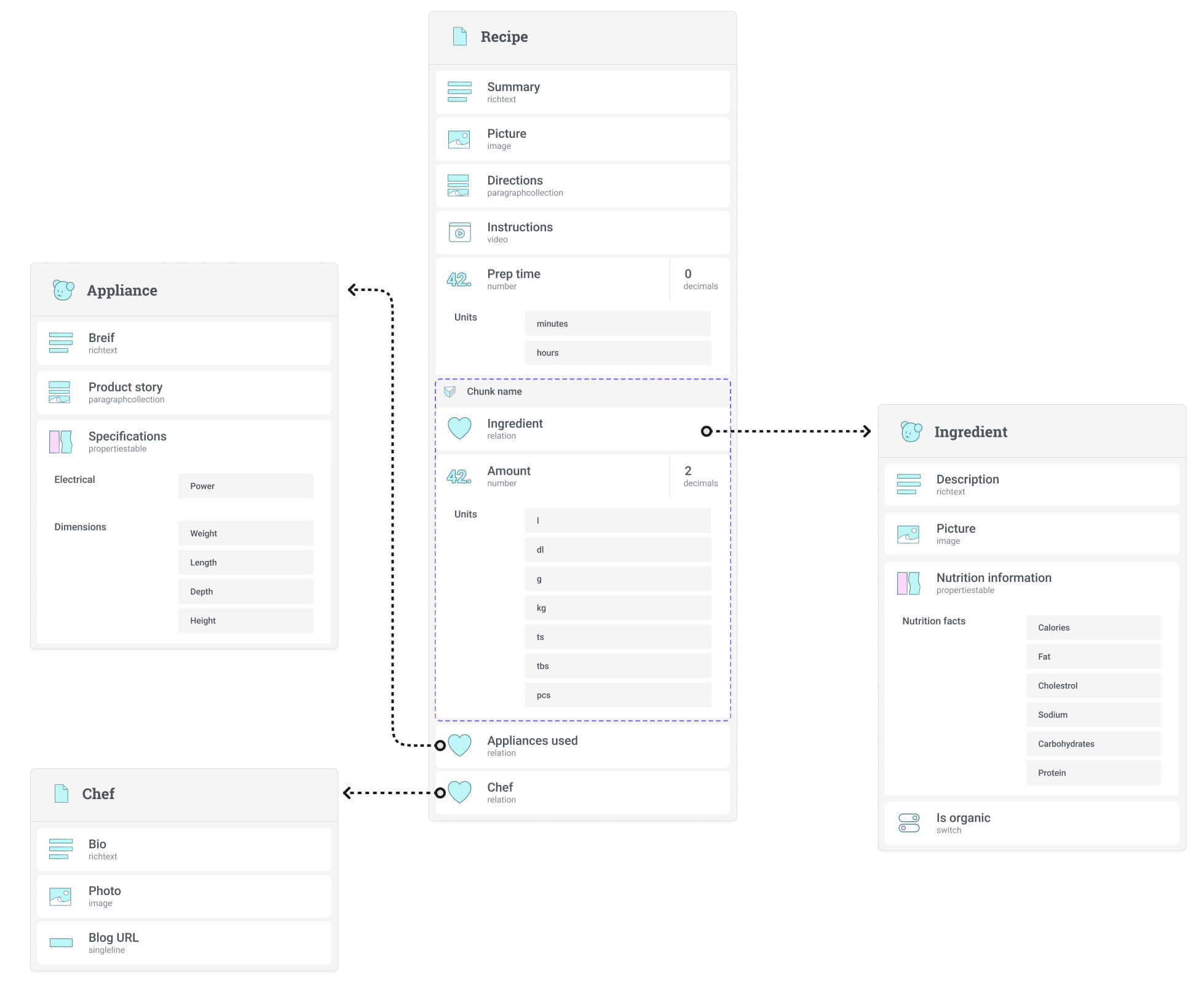
Why Content Modeling Matters?
Why should you care about content modeling? The short answer is that it solves a lot of content management headaches and offers significant benefits for your organization. The long one boils down to some of the key benefits and reasons content modeling is considered essential:
- Consistency and Quality: When all your content follows a defined structure, it becomes more uniform and higher quality. This consistency reduces errors and makes the content more predictable for both creators and consumers. Large teams, especially, benefit from this – it ensures everyone fills in content the same way, adhering to the same standards.
- Content Reuse and Omni-Channel Delivery: Structured content can be easily reused across pages and channels. For example, a product description written once can be used on the product page, in a marketing email, and on a mobile app without needing to be copied and pasted, making multi-channel publishing much more efficient, i.e., create content once and distribute anywhere.
- Efficiency and Scalability: By breaking content into smaller components, production workflows become more efficient and scalable. Different team members can work on different parts of the content in parallel (for example, one writes the copy, another designs/updates images, and a third works on product data). It’s also easier to add new content types or fields in the future without breaking everything.
- Faster Time-to-Market: A well-structured content repository enables you to generate new pages, categories, or even new sites more quickly.
- Improved Search and Navigation: Structured content is easier to search, filter, and present in dynamic ways, allowing for more efficient navigation. For example, if every event in your model has a date and location field, you can easily create a view of events filtered by date or location.
- Better SEO: Search engines and LLMs love structured content. When your content is well-organized (often paired with semantic HTML and/or schema markup), Google and LLMs such as Perplexity, ChatGPT, Anthropic, etc., can more easily understand and index it. We’ve talked about how a structured content model enhances SEO in our e-commerce SEO guide.
- Personalization and Future-Readiness: As digital experiences become increasingly personalized (often leveraging AI), having your content in discrete chunks enables you to assemble content tailored to each user dynamically. For example, you might show different content variants (such as green or red coffee machines) or mix-and-match pieces based on user preferences, which is only feasible when the content is modular.
- Cross-Team Alignment: Content models facilitate communication and collaboration among diverse stakeholders, including content strategists, writers, designers, developers, and marketers, by providing a shared understanding of the content's pieces or components within the Crystallize ecosystem.
Organizing Your Content
Designing a content model is part of the challenge; another part is organizing the content items themselves within your system so that editors and users can find and manage them. This is where you consider your overall information architecture – how content is stored, categorized, and presented structurally. There are several standard organizational systems for content, and you often use a mix of them.
Hierarchical Organization
This is the classic tree structure – content arranged in parent/child relationships like folders and subfolders. For example, a website might have sections and sub-pages in a hierarchy, or a product catalog might nest categories. Hierarchy is familiar (think of your hard drive’s folder tree) and is great for content that naturally falls into clear sections. In Crystallize, for instance, content items are organized hierarchically in a catalog structure.
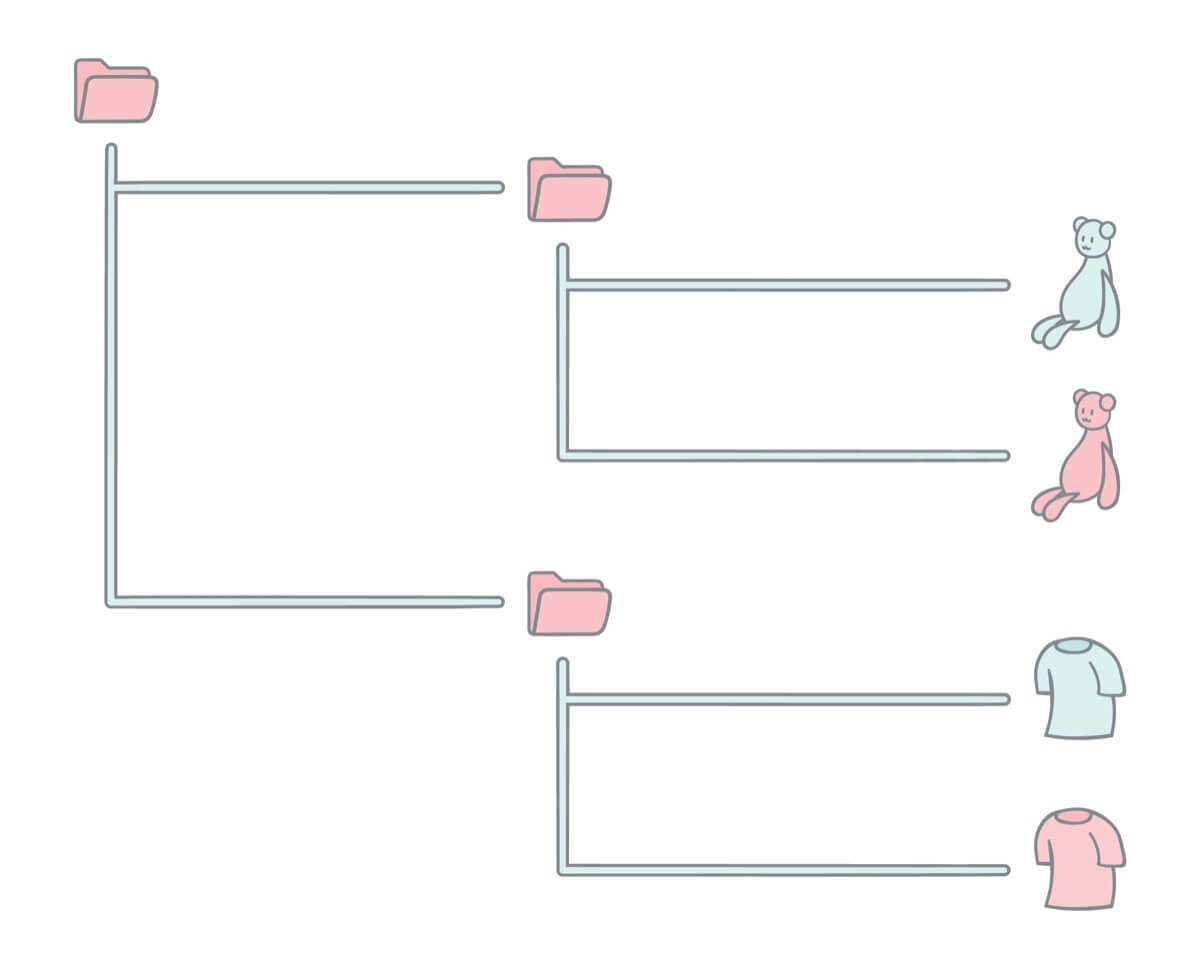
Use hierarchy when you have a clear one-to-many structure (e.g., a blog with categories, each containing posts). One downside is that a piece of content can only live in one branch unless you duplicate it, which is where the next system comes in…
Sequential Organization
This is essentially a linear order. It often goes hand in hand with hierarchy (a folder of pages might be ordered 1, 2, 3). Sequential organization is crucial for content that must be read in a specific order, such as step-by-step guides or onboarding emails (e.g., emails 1–5).
In web content, sequential structure is often implemented as the ordering of items within a category or a manual sort order for navigation. Crystallize notes that sequential organization is basically the ordering of items in a folder (a sequence). Think of it as the playlist or slideshow approach – items lined up in a deliberate sequence for consumption.
Topic (Taxonomy) Organization
A topic-based organization uses tags or categories to label content with themes, and often allows content to belong to multiple topics. This is more of a network or faceted approach rather than a strict tree. For instance, you might tag articles with topics like “AI” or “UX” or “Announcements,” and users can find all content tagged “AI” regardless of which section it lives in. Topics are managed in topic maps or taxonomies – essentially sets of tags that can themselves sometimes be hierarchical (like a taxonomy tree of topics).
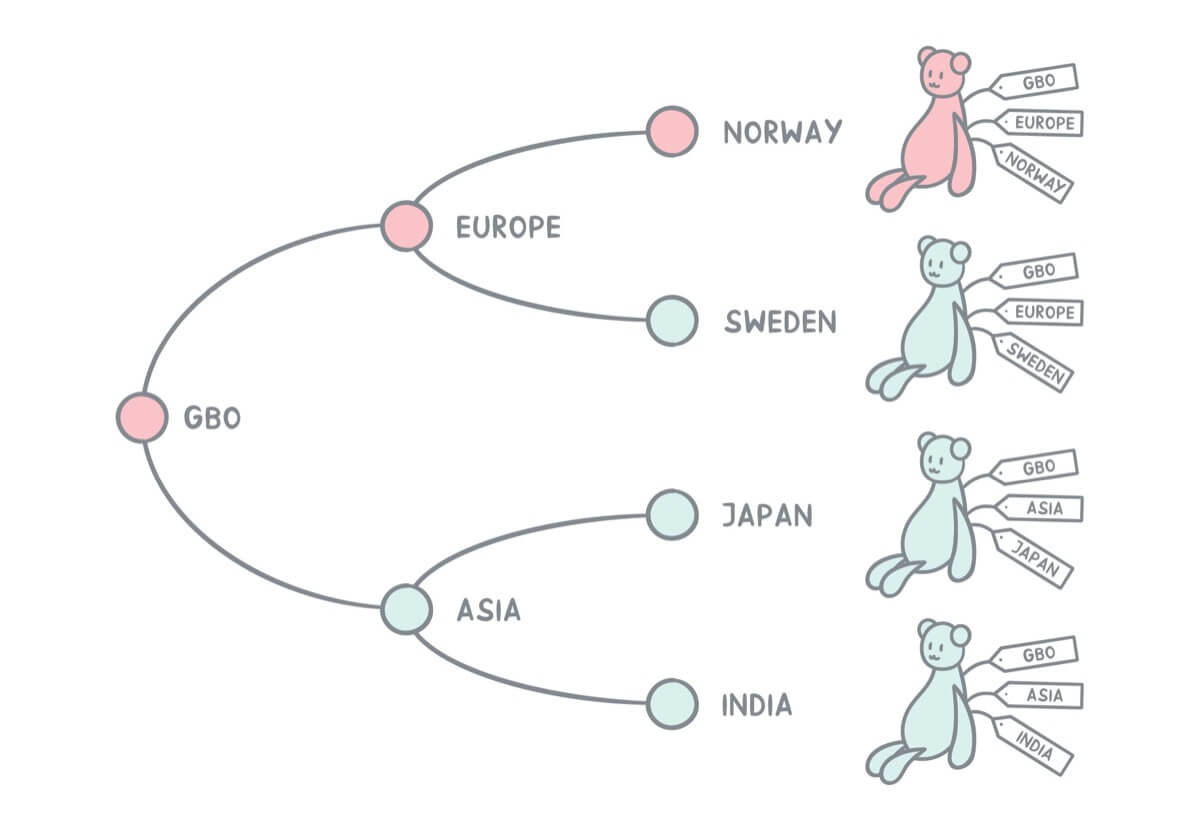
Topic organization is excellent for enabling content discovery across silos and for flexibility (a content item can have multiple tags). In our recipe example, topics could be cuisine types or dietary labels (like “vegan”, “gluten-free”), which cut across the hierarchy of a site. Implementing a robust taxonomy (and consistently tagging content) greatly improves findability.
Matrix (Grid) Organization
This is a less common but interesting system where content is organized in a two-dimensional matrix, often by two intersecting criteria. A simple example: an e-commerce site might have a matrix of product x season, or content pieces arranged by audience vs. content type. In practice, a matrix organization could be implemented via a combination of categories and tags to create a grid.
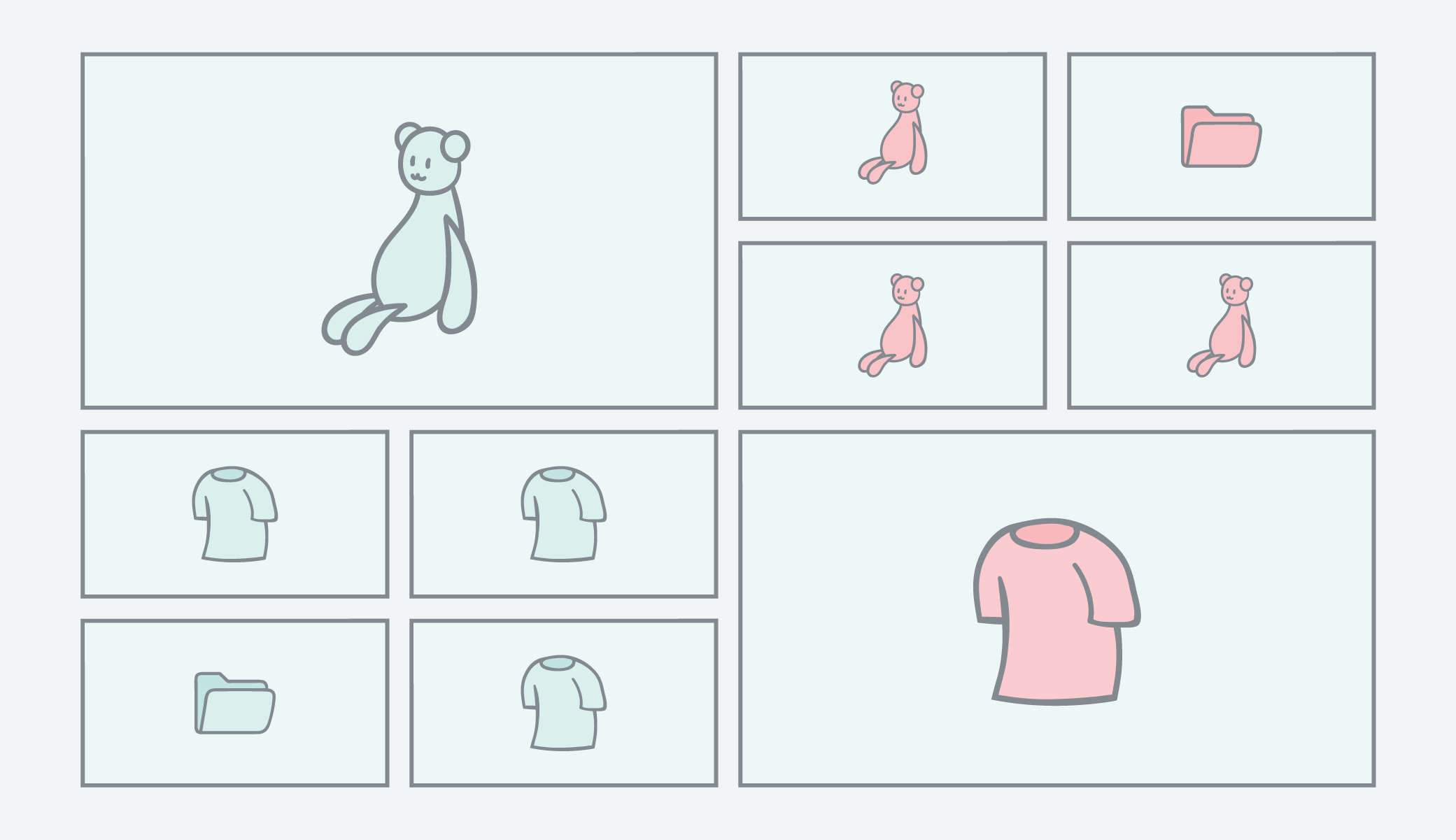
Crystallize provides a specific example: a grid organizer for products, where you might want to manage a selection of highlighted products for each combination of criteria (like a matrix of “season” vs “category”). In a matrix, content can be placed in a cell where a row and column intersect. It’s a bit more advanced and usually used for specific needs, like curated collections that span multiple dimensions.
🤿Going Deeper: Bridge Patterns for Smarter, Scalable Content Models
Once you understand shapes, components, and relationships, you’re ready for the next layer of modeling maturity: data modeling design patterns. Think of these as structural helpers that let you express meaning, variation, rules, and multi-dimensional relationships without turning your catalog into a maze. Bridges give your model depth; they help you go from “content that fits” to “content that adapts, stays clean, and scales elegantly.”
Bridge patterns introduce a way to structure meaning directly into the model. So complexity lives where it belongs: inside the schema, not scattered across your frontend code, exports, or team tribal knowledge.
Here’s the quick tour of the couple.
Semantic Classification Bridge: meaning-first organization. Use this when your content sits in conceptual groups rather than mechanical ones. Think “materials,” “themes,” “topics,” “sales categories.” It’s about identity and storytelling.
Best use cases: Editorial categorization (topics, narratives, themes); Product meaning (material type, collection story, seasonal themes).
Business benefit: richer merchandising and more intuitive filtering.
Dev benefit: consistent, predictable taxonomies that don’t mutate under pressure.
Quantised Classification Bridge: clean buckets for numeric chaos. Instead of modeling raw numbers everywhere, quantisation lets you define discrete buckets: size ranges, volumes, capacities, and age brackets. It simplifies how customers browse and how editors maintain data.
Best use cases: Apparel sizes; Volume/capacity brackets; Age ranges or product suitability segments.
Business benefit: clearer UI filters, fewer misclassified products.
Dev benefit: consistency; no need to validate 500 slightly different numeric values.
Conditional Classification Bridge: when one choice depends on another. This is your logic layer. If one attribute influences another—such as color restricting material options or region-specific tax rules—you capture that dependency at the modeling level.
Best use cases: Product configurators; Region-specific compliance/availability; Bundles or kits with conditional options.
Business benefit: fewer order errors, less manual correction, better regional personalization.
Dev benefit: logic is centralized; your frontend stays thin and reusable.
Composite Classification Bridge: multidimensional variants done right. When product identity depends on multiple attributes—such as size, color, and material—this bridge lets you define valid combinations without creating bloated shapes or endless permutations of variants.
Best use cases: Fashion product matrices; Furniture configuration (fabric + legs + finish); Electronics with multi-attribute variants.
Business benefit: cleaner catalog, faster product launches, improved navigation.
Dev benefit: no more variant spaghetti; combinations are explicit and controlled.
Bridges elevate your content model from descriptive to intentional. They help you encode meaning, structure variation, and prevent fragmentation before it becomes a maintenance nightmare.
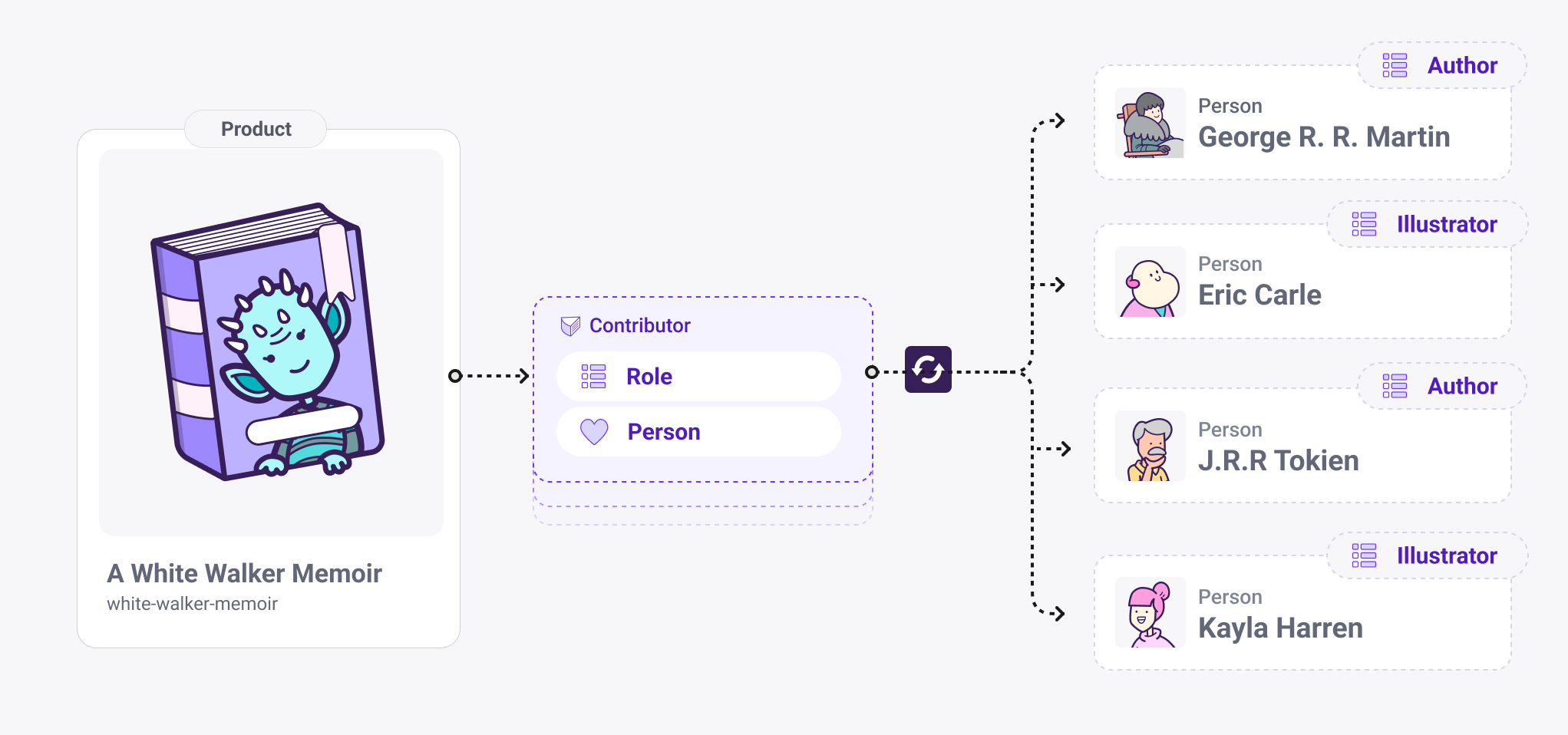
Setups and Examples
In most platform setups, hierarchical and tag-based (taxonomic) structures are both used. For instance, you store content in a tree structure for URL and navigation purposes, and you tag content with topics for cross-linking and filtering. The right approach depends on your content and the needs of your users. The goal of any organization system is to make content easy to find, reuse, and maintain. So ask: how will content managers locate content in the PIM/commerce/CMS (by browsing a hierarchy or by searching tags)? How will end-users find content (via site navigation hierarchy or via filtered search by topic)? Often, providing multiple avenues (such as navigation menus, search, and topic filters) covers all bases.
A quick example to illustrate these. Suppose you run an online store. You might organize products hierarchically by category (e.g., Electronics > Mobile Phones > Smartphones). Within a category, you might have a sequential arrangement (maybe sorted by newest or a manual featured order). You can also tag products by attributes like “On Sale” or “Eco-Friendly” (topic organization), allowing customers to find all sale items or eco-friendly items across categories easily. You could have a matrix for a page that highlights seasonal products, with rows representing seasons (e.g., Summer, Winter) and columns representing categories (e.g., Clothing, Gadgets), filling each cell with the appropriate items – managed via a grid in the backend.
The key is to design an organizational approach that complements your content model. Content modeling (defining structure) and content organization (structuring how content is stored/found) go hand in hand. One ensures that each item has internal structure; the other ensures that all items have a sensible external structure within the system.
From a technical perspective, implementing these might involve utilizing the platform’s features, such as content trees for hierarchy, tagging or taxonomy modules for topics, and possibly custom collections or queries for matrices. Crystallize, for example, uses a catalogue (tree) and also supports topics and grids.
Content Modeling Is a Means to an End…
…that end being better content outcomes. When done right, it enables your team to spend less time wrestling with format and structure and more time creating great content and user experiences. It’s a foundational investment that can pay off in smoother workflows, happier content teams, and more engaged audiences who get content that’s always in the right place at the right time.
If you’re ready to dive into content modeling, check our Step-by-Step Guide and start with something small: pick a section of your site or a type of content and map it out.
Play with ideas, involve others, and iterate.
Over time, you’ll refine a model that fits your needs like a glove. And your content will thank you for it – by being more organized, impactful, and scalable than ever before.
Happy content modeling! 🚀
SCHEDULE A 1-on-1 DEMO to explore how content modeling in Crystallize can help you achieve your goals. Or, why not START building for FREE.
🧩Content Modeling Series Posts

Content Modeling Step-by-Step Guide
Content modeling, how is it done? It's not as tricky as it sounds! It usually starts with some good old-fashioned brainstorming and planning, often in team workshops.

Content Modeling Tools
You can certainly sketch out content models on a whiteboard or in a notebook – and many teams start exactly that way. But it's better to use tools built for content modeling, right?

